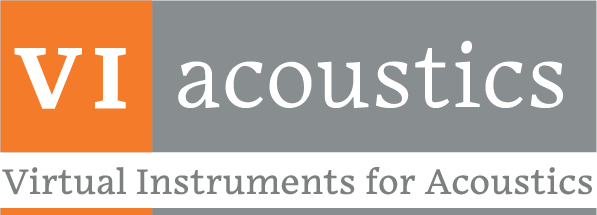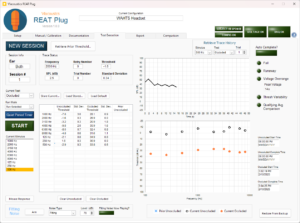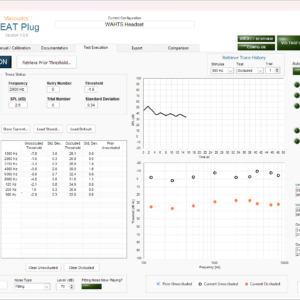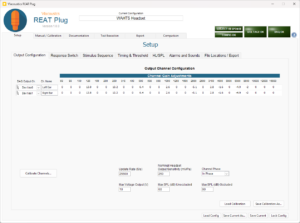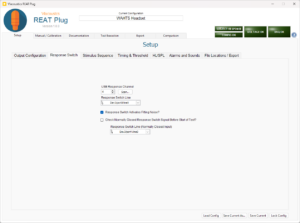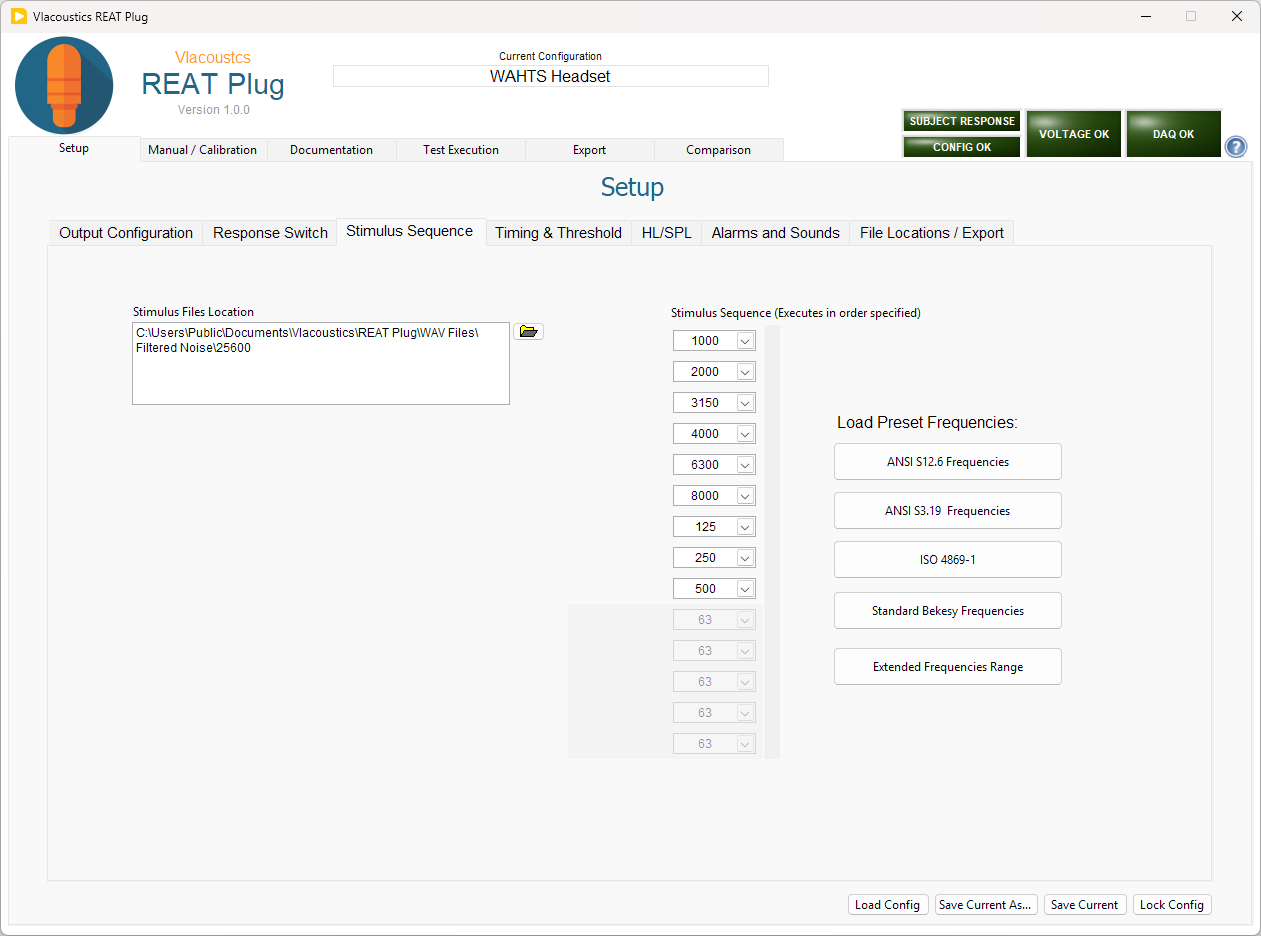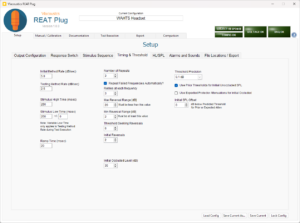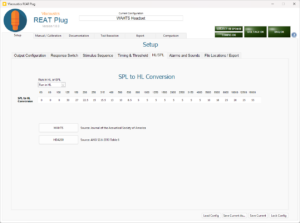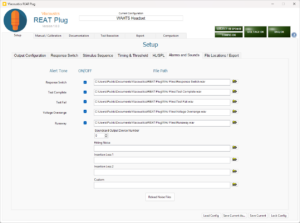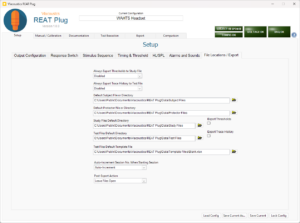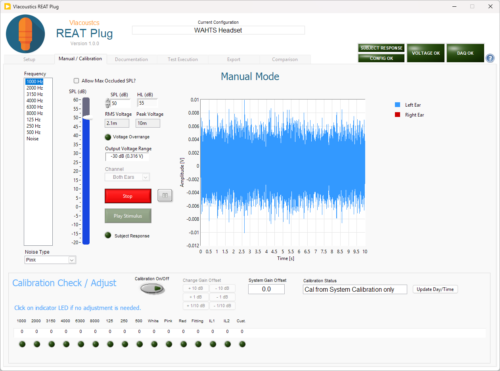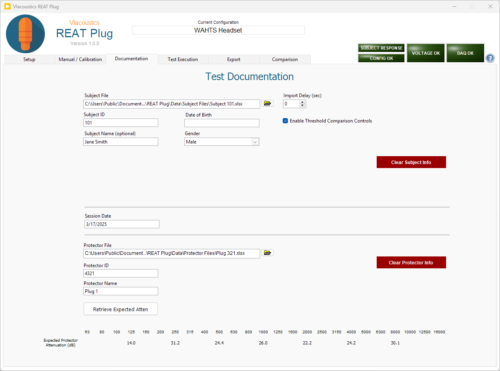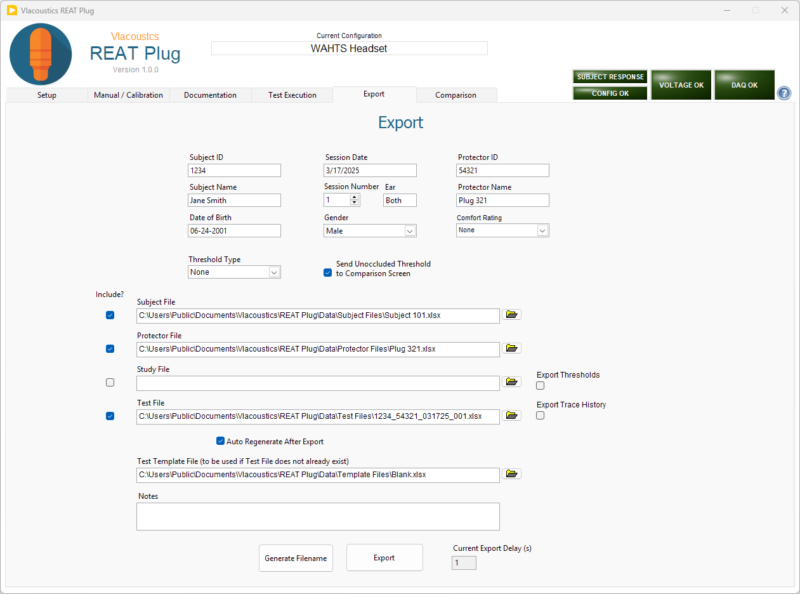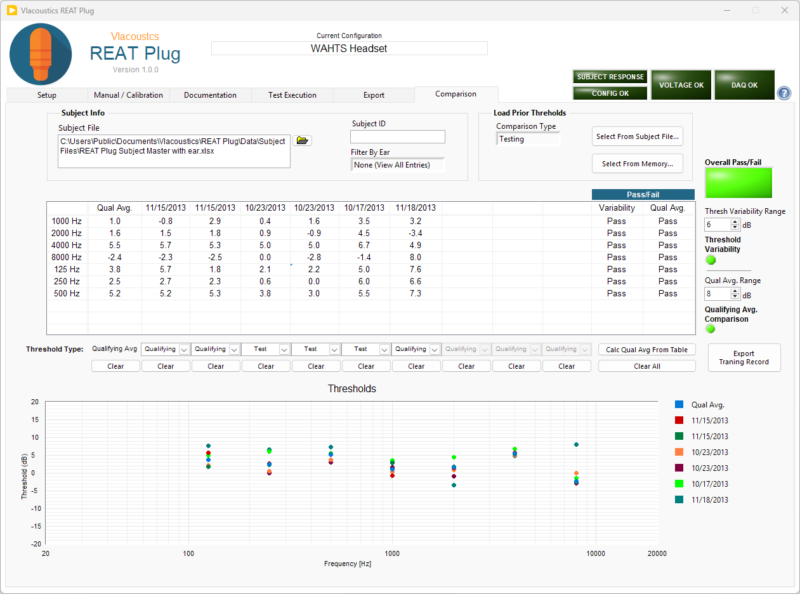Overview
REAT Plug is a software application that conducts boothless Real Ear Attenuation at Threshold (REAT) measurements on earplugs, in accordance with the standard test methods*. REAT Plug does not require an acoustic test chamber or sound system. Instead, it uses a special audiometric headset, which provides ambient noise isolation while outputting calibrated test signals. The attenuation of the headset is comparable to that of single wall audiometric testing chamber, which gives hearing professionals the flexibility to conduct testing in a wide array of acoustic environments.
REAT Plug operates on NI PXIe-4468 series hardware and a custom modified version of the WAHTS Hearing Audiometric Headset. It is interests much of its feature set from our REAT Pro system: it is an automatic Bekesey audiometer program designed to provide stimulus and track responses for sound field hearing threshold determination for both occluded and unoccluded conditions. REAT Plug also provides calibrated signal generation for fixture based tests.
Features:
- Tracks both unoccluded and occluded hearing thresholds
- Can output signals to either ear, or both simultaneously
- Provides both thresholds and trace history
- Provides tools for headset calibration
- Data export into Excel for post-process analysis and reporting
REAT Plug and REAT Pro are the fourth generation of the REATMaster software originally developed in 2007 by Nelson Acoustics Software for the NASA Glenn Research Center and in conjunction with technical input from NIOSH. In 2010 the REATPlus second generation application of hearing protector evaluation was released which added additional features. In 2014 REATPro was released and has been adopted by several large hearing protector manufacturers and government hearing protector laboratories. REATPro has been enhanced with additional features and is now supported by VIacoustics for laboratories with an interest in hearing protector attenuation measurement.
*Standardized test methods:
Code of Federal Regulations (CFR) 40, Part 211, Subpart B – Hearing Protective Devices
ISO 4869-1:2018 Acoustics — Hearing protectors — Part 1: Subjective method for the measurement of sound attenuation
ISO 4869-3:2007 Acoustics — Hearing protectors — Part 3: Measurement of insertion loss of ear-muff type protectors using an acoustic test fixture
ISO/TS 4869-5:2006 Acoustics — Hearing protectors — Part 5: Method for estimation of noise reduction using fitting by inexperienced test subjects
ANSI S12.6 – Methods for Measuring the Real-Ear Attenuation of Hearing Protector
ANSI/ASA S12.42 American National Standard Methods for the Measurement of Insertion Loss of Hearing Protection Devices in Continuous or Impulsive Noise Using Microphone-in-Real-Ear or Acoustic Test Fixture Procedures
ANSI S3.19 – Method for Measurement of Real-Ear Protection of Hearing Protectors and Physical Attenuation Ear Muffs
Australian/New Zealand Standard 1270:2002, Acoustics – Hearing Protectors
Features
- Automated threshold detection through a configurable frequency sequence
- Sequencing modes include:
- Run All Frequencies
- Run Selected Frequency
- Run From Selected Frequency
- Measures unoccluded and occluded thresholds
- Results displayed in an audiogram and table
- Can test either Left, Right, or Both ears simultaneously
- Unoccluded and occluded modes have separate max level protections to ensure subject safety
- Real time level indication and trace tracking
- Can import prior subject thresholds to display on Audiogram as a baseline comparison
- Can issue warnings indications based on Threshold Variability and Qualifying Average Comparison limits
- Fitting noise playback, controllable by the subject’s response switch
REAT Plug provides flexible configuration options to support a variety of data acquisition systems and audiometric testing protocols.
Left and Right headset outputs are configured on the Output Configuration subtab. Equalization is available for each channel, as well as system wide, in order to generate a uniform sound field and achieve maximum repeatability.
In the Response Switch tab, the switch device input is selected. REAT Plug uses a USB response switch and includes a scanning feature to automatically detect the appropriate device number. There is also an option for the subject to activate fitting noise with the response switch.
The REAT Plug Stimulus Sequence setup tab allows you to configure the frequencies to be presented and the order in which they will be presented. Preset frequency lists and presentation orders that meet industry standards are provided for quick configuration of the stimulus sequence. Or use customized stimulus from WAV files and utilize the extended frequency range (63Hz – 16kHz) to help further your research.
The REAT Plug Timing and Threshold configuration screen provides complete user control over the audiometric threshold determination parameters associated with the test. Threshold seeking rates and reversal count settings can be controlled here in order to either reduce time to threshold or increase the accuracy of the thresholds.
Use of prior subject threshold and expected protector attenuation also reduces the time it takes to reach both unoccluded and occluded hearing thresholds.
The HL/SPL tab gives the option to report thresholds as hearing level or sound pressure level and makes the conversion as per ANSI S3.6-2010.
The Alarms and Sounds setup screen allows remote operator monitoring of test. The test operator can also configure custom alert sounds for system events and custom noises for fitting and insertion loss measurements, all from user defined WAV files.
Contact us about the Audio Filter Toolkit to generate custom WAV files equalized for your chamber.
The File Locations tab is used to configure how data is saved to a local or network drive. Data can be sorted by subject threshold history, protector testing history, or by study files for specific research or noise reduction ratings.
REAT Plug configuration settings can be saved and reloaded into REAT Plug when the application is first started. This allows the test facility technical manager to optimize the system configuration settings for the unique needs of the laboratory, and then the test technician can simply be taught to retrieve this settings file when REATPro is started. Configuration files can be password locked to prevent changes by system users.
The Manual / Calibration tab can be used to present and calibrate any stimulus at any level to any or all outputs, continuously or pulsed. This can be useful for subject training, checking that the sound system is functioning and troubleshooting problems.
Creates test documentation and retrieves prior thresholds from subject for comparison with current thresholds as required by ANSI S12.6.
- Define test type: qualifying subject, training as subject, conducting protector test.
- Subjects are tracked by subject ID for HIPA compliance.
- Document what protector is being tested.
- Load expected attenuation to speed up occluded threshold seeking.
REAT Plug provides seamless data export to Excel based template files that users can customize to meet their own data analysis and reporting needs. Both Unoccluded and Occluded thresholds, as well as the standard deviations of the trace reversal mid points used to derive the threshold are exported. A file header section provides documentation on all test setup parameters. Optionally, users may also export the sound pressure level vs time trace history to Excel for detailed analysis of threshold determination time and reversal history.
